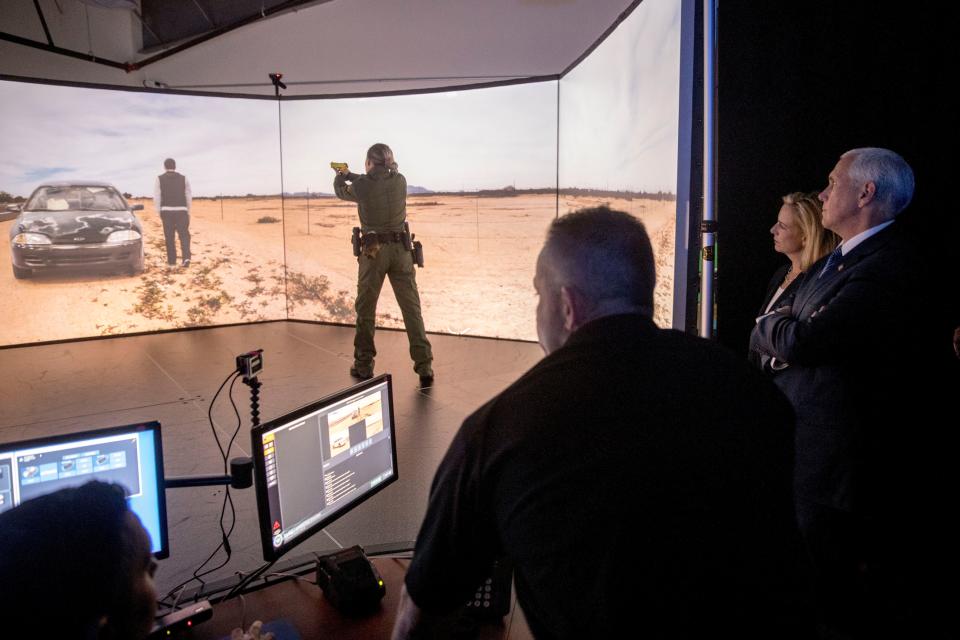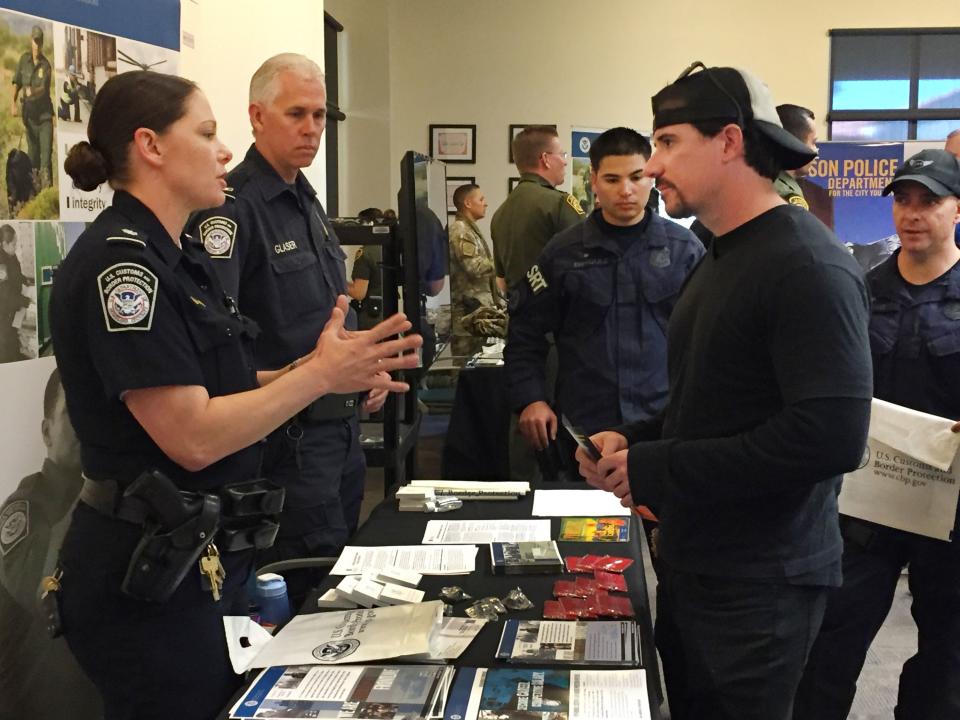Border Patrol struggling to hire, keep agents, but may never get 5,000 Trump ordered
When U.S. Border Patrol agents called on the patrol's air unit to provide overhead coverage for operations, about four out of five requests were rejected over three recent years.
The reason? A lack of pilots.
And the staffing crisis at Border Patrol doesn't end with pilots.
As President Donald Trump's attention is focused on building a border wall to keep out unwanted migrants, the Border Patrol's "human wall" is in a serious state of disrepair, according to a USA TODAY review of government documents, congressional testimony and interviews with agents.
The Border Patrol, a component of U.S. Customs and Border Protection, faces a crisis in hiring, training and retaining agents as well as keeping track of what exactly its 19,555 agents are doing at any given time, according to internalwatchdogreports.
Trump: 'I know a lot about wind,' president says. A government FAQ proves he doesn't
Trump rally: 'AOC sucks!' chant breaks out at Trump's Michigan rally against Rep. Alexandria Ocasio-Cortez
As the Border Patrol struggles to maintain current workforce levels, its greatest challenge will be President Trump's executive order from two years ago calling for the hiring of an additional 5,000 agents to seal off the southern border.
Since that Jan. 25, 2017, order, what should have been a flood of hiring has been, at best, a trickle. In 2018, the agency added 118 Border Patrol agents, with only three stationed along the southern border.
That shortfall is part of the reason Trump has deployed thousands of National Guardsmen and active-duty military troops to the southern border and has left agency officials questioning whether the 5,000-agent goal will ever be realized.
"I can't necessarily say whether we'll be able to meet it at this point," said Temea Simmons-Collins, acting executive director for the talent management directorate at Customs and Border Protection.
'Breaking point has arrived'
When acting Inspector General John Kelly of the Department of Homeland Security appeared before the House Appropriations Committee on Homeland Security on March 6, he voiced similar reservations.
"They will be challenged to achieve their goals. They have not achieved their goals in the past," Kelly said at the hearing.
Even if the agency succeeds in recruiting and hiring thousands of agents, it wouldn't be able to train them properly, Kelly said.
"Our recent audit determined that the federal law enforcement training centers did not have the capacity to train all the law enforcement officers CBP and (Immigration and Customs Enforcement) intended to hire," Kelly told the subcommittee.

For two decades, and over multiple administrations, Border Patrol experienced steady growth. Border Patrol increased in size every year from 1994 to 2011, when it reached its peak of 21,444 agents. But the agency has been shedding agents ever since, dropping each of the next six years before the small increase in 2018.
"These personnel shortages create national security risks. They slow the movement of commerce and put an additional strain on already overworked border enforcement workforce," Rep. Dan Crenshaw, R-Texas, a member of the House Homeland Security Subcommittee on Oversight, Management and Accountability, said at a hearing in March on the agency's hiring challenges.
On a visit Wednesday to El Paso, CBP Commissioner Kevin McAleenan said the record-breaking number of asylum-seeking families has completely overwhelmed his agents' ability to house and process them.
"The breaking point has arrived," McAleenan said.
Trump: I've helped Puerto Rico more than 'any living human being,' alleges officials misspending funds
'I'll punch the bully in the mouth':Puerto Rico governor warns Trump over Maria relief
Border Patrol agents hard to keep
The agency has struggled to hire and retain agents for a wide variety of reasons.
Their work schedules can change quickly, they're regularly asked to work overtime, and they're required to patrol some of the most treacherous sections of the border. In the past 17 years, 41 Customs and Border Protection employees have died in the line of duty, according to agency data.
For agents, the mental toll can be dire. Agents are forced to live and work in some of the most remote outposts in the country. One example is the border crossing in Lukeville, Arizona, a community of 50 people that features one gas station and one small grocery store. The nearest school and medical clinic are 39 miles away, and the groundwater has traces of arsenic.
Such stress might help to explain why over 100 CBP employees have committed suicide over the past 12 years, according to agency data.
"Our jobs are not for everyone," Benjamine "Carry" Huffman, an acting executive assistant commissioner at CBP, testified during a House committee hearing this month.

To address those challenges, Border Patrol has been forced to get creative in its recruiting practices.
About 30 percent of Border Patrol agents are military veterans, so the agency has permanent recruiting offices at Fort Bragg, Camp Lejeune and other bases. They recruit heavily online, through job sites and paid advertising tied to social media and email services.
From 2015 to 2016, the agency nearly tripled its recruiting events around the country, now conducting about 3,000 a year. That includes CBP booths at job fairs, festivals and college campuses, which have drawn protests from students. The agency has also focused on country music concerts, NASCAR races and Professional Bull Riders events to find applicants.
Turning to rural America for recruits
The agency is expanding outreach with a new branding campaign called "Go Beyond."
Agency officials say their research indicates their jobs are already well known through the border region and among military veterans, but not so in other parts of the country. That's why the campaign will be a national one, specifically targeting rural pockets of the country.
"Middle America is definitely a place that we're targeting," said Rob Smith, CBP director of national recruiting. "When you take a look at the landscape, you have a lot of land, it's more remote…which mirrors a lot of what you're going to find on the southern border."
The agency has also tried to change its hiring process to get more people through the rigorous application pipeline. Border Patrol agents must pass an entrance exam, physical fitness test and drug screening. They must clear an extensive criminal background check, and pass a congressionally mandated polygraph examination to root out applicants who are members of drug cartels or could be bought off by criminals.
So onerous is the process that the Department of Homeland Security Inspector General estimates that Border Patrol must screen 750,000 applicants to hire 5,000 new agents.

To cut that down, Customs and Border Protection has instituted a "Fast Track" hiring process "that streamlines the hiring process." That includes shortening the entrance exam from four hours to three and changing medical screenings "to reduce the number of applicants requiring medical follow-up."
More: ICE sets record for arrests of undocumented immigrants with no criminal record
The agency also changed the polygraph exam and convinced Congress in 2016 to waive the exam for some veterans. CBP has said there are a limited number of people qualified to conduct polygraph exams in the country, leading to a bottleneck that has slowed down hiring dramatically.
But a July report from the inspector general's office showed the importance of the exam: from 2013 to 2016, about 41 percent of applicants failed the polygraph, and another 26 percent admitted to behavior that disqualified them, including using illegal drugs, molestation, domestic violence and even being an accessory to murder.
Despite the hiring challenges, Customs and Border Protection officials insist they are not hiring questionable agents.
"The hiring standards that we set forth … are still being met. The quality of applicants are still being met," said Simmons-Collins, the talent management director at CBP.
Customs and Border Protection has also come under fire for a $297 million contract it awarded to Accenture, a government contractor brought in to improve the agency's hiring process. The company was supposed to receive $40,000 per new hire.
The contract was awarded in November 2017. By October 2018, the company had completed only two new hires but been paid more than $13.6 million, according to a Homeland Security inspector general report. Customs and Border Protection defended the contract, arguing that Accenture had reformed the agency's hiring practices and had completed 22 hires by December 2018.
Still, the agency issued a "partial stop" order on the contract in December, meaning Accenture will not receive the full $297 million it could have earned, and its role in directly hiring applicants will be reduced.
"CBP continues to see positive results from activities related to marketing, advertising, applicant care and data analytics which have contributed to the thousands of applicants currently in the hiring pipeline," the agency said in a statement.
Too much time spent on support functions
Another part of the problem is that Border Patrol hasn't completed a congressionally mandated workforce staffing model to track exactly what its agents are doing each day. Agents use one system to input their daily schedules, and a separate payroll system to fill out the hours they worked, but the two systems aren't synchronized and changes in work performed are not always filled in.
That leaves Border Patrol senior managers "unable to definitively determine the operational need or best placement for the 5,000 agents the Department of Homeland Security was directed to hire," the agency's inspector general found.
"A lack of mission support personnel in U. S. Border Patrol forces Border Patrol agents to conduct support functions. These support functions include clearing brush on roads, moving ground sensors, fixing the border fence, managing station budgets and serving as full-time vehicle maintenance managers," the February report stated.
Border: CBP commissioner says immigration system at 'breaking point'
The report cited a 2017 exercise that highlighted how the agency may be under-performing due to its inability to track its agents' duties. For two weeks, Border Patrol supervisors in the Rio Grande Valley Sector in Texas moved more than 500 agents from support roles away from the border to active patrol roles along the border.
During that trial, apprehensions of undocumented immigrants rose 2.7 percent, "turnbacks" of Mexican nationals to Mexico rose 7.6 percent, and agents were able to spot 25 percent more "gotaways" — undocumented immigrants who successfully evaded Border Patrol and entered the U.S.
That led the inspector general to continue urging Border Patrol to finish its workforce staffing model so it can better track the agents it has and place them in the best possible positions to seal the border. Of the 16,717 agents assigned to the southern border in 2017, only 61 percent were actually patrolling the border.
"Without comprehensive staffing models, operational needs analyses and deployment strategies, CBP … will not be able to identify clearly the correct number and type of employees required, what positions must be filled, or where to deploy those employees," the report concluded.
Immigration: Confused by terms in the debate? Here are some common ones defined
The Wall: An in-depth examination of Trump's proposed border wall
This article originally appeared on USA TODAY: Border Patrol struggling to hire, keep agents, but may never get 5,000 Trump ordered

